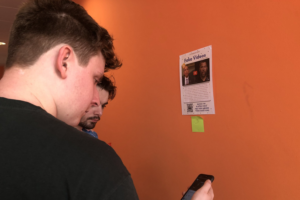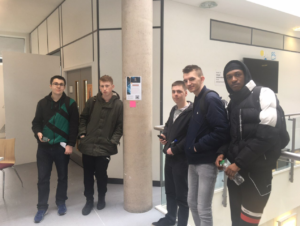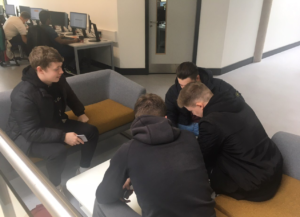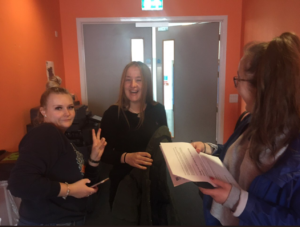Saving journalism from the robots of the future with emerging technologies
Journalism academics, Caroline Jones and Suzanne Nelson, felt their students would benefit from discussion about, and an examination of, the future of journalism, in relation to emerging technologies that are currently being developed. It was felt that this had to be achieved in a fun and memorable way, with the idea being that gamification can improve the students’ engagement and enhance their knowledge (Kapp, 2012; Tsay, Luo and Kofinas, 2018, Villagrava et al., 2014). As a result, they developed a treasure hunt-style workshop, together with Charlotte Ellis, from the University’s CELT team. It transported the students to 2059, where they were required to learn about the potential problems associated with robot or AI-led journalism and to learn how to use advanced digital storytelling skills and technologies, such as augmented reality (AR). The main aim of the workshop was to emphasis to the students the importance of adaptability in relation to technology and journalism; ultimately, to be prepared for new ways of telling stories that would emerge throughout their careers.


The session was inspired by the TEL PGCHE Escape Rooms session, which was to demonstrate to academics the potential of using technology within their teaching. Caroline and Suzanne recognised, in the case of journalism, this technology was not only relevant to them in order to enhance the quality of the teaching and learning experience, but it also offered them new digital storytelling tools to explore with their students. In this sense, they linked the Escape Rooms session to a workshop they could develop to show their journalism students what they needed to understand about the technology they could use now and how it might evolve during their careers in the future. By running the session in this way, it also aims to improve the students’ learning environment, along with increasing their digital capabilities.
The workshop was a collaboration between two teams across the university, the CELT team and journalism, with a combination of face-to-face and online collaboration. This also involved technology to build a session for the students, by using online working documents, storyboards and shared documents of the different elements involved in the workshop. The workshop itself assisted the students through understanding a number of technologies that are being used in journalism, from Artificial Intelligence (AI), Augmented Reality (AR), Virtual Reality (VR), 360 videos and robot-written stories. The students were given video instructions to begin the task, which lead them to their first location. The students worked through a process of reading or watching a news item about one of the subjects and then answering questions about what they had learnt. If these were answered correctly, they were then given the next location to move forward. During the workshop, the students were spilt into groups of 4/5 and not only learnt about the technology being used to tell stories but also had to create stories with these technologies as well. They were tasked with creating a video article, a QR code which linked to a relevant website and finally an AR element to their journalist piece. By working through all these different elements, the students not only learnt and tested their knowledge throughout but could also put into practice some of these new-found digital capabilities. This is important because increasing students’ digital capabilities will enhance their opportunities for employment after graduation (Knight, 2011; Beetham, 2015). The session was run for the news, football and sports journalism students; with slightly different scenarios presented to each cohort to make the workshop more relevant to their area of study.
Impact
By the end of the workshop, students felt they had both learnt something new and enjoyed the opportunity to try some of the technologies themselves. Feedback from the students was positive, with some even expressing themselves through social media.


This approach worked well to assist students with improving the digital skills required for their future careers in journalism, as well as improving the teamwork and engagement levels across the cohort. Understanding the logistics of the workshops was extremely important; being flexible with the groups, locations and not being limited to a classroom added to the gamification learning aspect. To go alongside this, giving a debrief to all the participating students at the same time was almost impossible, as they finished at different times. Therefore, a debriefing was given to each group individually.
Be adaptable
However, the planning workload from the academics and the CELT team was quite high to make sure everything would work smoothly. This also meant a certain level of bravery was needed; as this kind of session may not appeal to some students, while others will engage with it in different ways. For example, some students saw it as a fast game of who could finish first, but did they get it everything out of it? The academics did try and solve this issue by offering prizes for the best videos, best QR code and even slowest time taken to complete the treasure hunt, to emphasise to the students that they should be taking in what was being presented to them and not simply racing through the experience. The academics would run this kind session again and have definitely learnt a lot from doing it. But they will mainly take away the idea of being flexible; being aware of hic-ups and having plan B, C, Ds…. in case anything happens. This includes understanding that the students may not fully read the instructions, or that elements of the treasure hunt placed around the university could be removed. By being aware of this and knowing how you will deal with, it helps. Be prepared!
Caroline Jones (C.Jones5@derby.ac.uk / 01332 593010), Suzanne Nelson; (S.Nelson2@derby.ac.uk) and Charlotte Ellis (C.Ellis@derby.ac.uk / 01332 593728)
If you wish to submit a proposal for a future Ideas Factory post please submit using this form.
Beetham, H. (2015) Deepening digital know-how: building digital talent., Jisc.ac.uk. Available at: http://repository.jisc.ac.uk/6259/1/Deepening_Digital_Knowledge.pdf (Accessed: 20 April 2018). Kapp, K. (2012) The Gamification of Learning and Instruction: game-based methods and strategies for training and education. San Francisco: Pfeiffer. Knight, S. (2011) Digital literacy can boost employability and improve student experience. Available at: https://www.theguardian.com/higher-education-network/blog/2011/dec/15/digital-literacy-employability-student-experience (Accessed: 29 May 2018). Tsay, C. H.-H., Luo, J. and Kofinas, A. (2018) ‘Enhancing student learning experience with technology-mediated gamification: An empirical study’, Computers & Education, 121, pp. 1–17. Villagrava, S. et al. (2014) ‘Teaching Case of Gamifacation and Visual Technologies for Education’, Journal of Case on Information Technology, 16(4), pp. 38–57.

